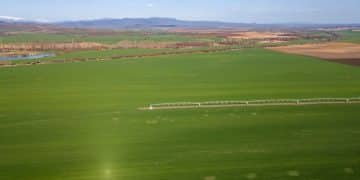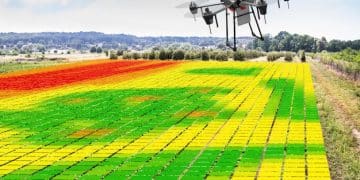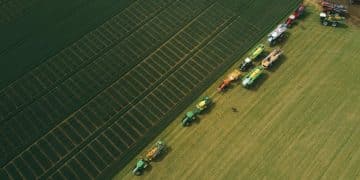Smart Farming System: A Step-by-Step Guide for US Farmers

Implementing a smart farming system involves integrating technology like sensors, data analytics, and automation to enhance efficiency, sustainability, and profitability for US farmers, requiring a strategic, phased approach.
Are you a US farmer looking to enhance your farm’s productivity and sustainability? Implementing a smart farming system can be a game-changer.
Understanding Smart Farming and Its Benefits
Smart farming, also known as precision agriculture, utilizes technology to optimize farming practices. It’s not about replacing traditional farming knowledge but rather augmenting it with data-driven insights.
By leveraging data, farmers can make more informed decisions about everything from planting and irrigation to fertilization and pest control. This leads to increased efficiency, reduced waste, and improved yields.
What is a Smart Farming System?
A smart farming system integrates various technologies to collect, analyze, and act on data. These technologies include sensors, GPS, drones, data analytics software, and IoT devices.
- Sensors: Monitor soil moisture, temperature, and nutrient levels.
- GPS: Enables precise navigation for machinery and targeted application of resources.
- Drones: Provide aerial imagery for crop monitoring and early detection of problems.
- Data Analytics: Processes data to provide actionable insights for farmers.
These components work together to create a comprehensive system that allows farmers to make data-driven decisions.
Key Benefits of Smart Farming
Implementing a smart farming system offers numerous benefits that can significantly impact the success of your farm.
- Increased Efficiency: Optimize resource use and reduce waste.
- Improved Yields: Enhance crop health and productivity.
- Reduced Costs: Lower input costs through precise application of resources.
- Sustainable Practices: Minimize environmental impact through efficient resource management.
These benefits translate to a more profitable and sustainable farming operation.
Adopting smart farming technologies can seem daunting, but the long-term benefits make it a worthwhile investment for US farmers.
Assessing Your Farm’s Needs and Resources
Before diving into implementing a smart farming system, it’s crucial to assess your farm’s specific needs and available resources. This assessment will help you determine the most appropriate technologies and strategies to implement.
Consider factors such as the size of your farm, the types of crops you grow, and your current farming practices. This information will guide your technology selection and implementation plan.

Conducting a Farm Assessment
A comprehensive farm assessment involves evaluating various aspects of your operation to identify areas where smart farming technologies can make the most significant impact.
- Soil Analysis: Understand your soil’s composition and nutrient levels.
- Water Management: Evaluate your irrigation system and water usage.
- Crop Health: Assess the current health and productivity of your crops.
- Equipment Inventory: Document the types and condition of your existing equipment.
This detailed assessment will provide a baseline for measuring the effectiveness of your smart farming system.
Evaluating Available Resources
In addition to assessing your farm’s needs, it’s essential to evaluate the resources you have available for implementing a smart farming system.
Consider your budget, technical expertise, and access to internet connectivity. These factors will influence the technologies you can realistically adopt and implement.
By carefully assessing your farm’s needs and resources, you can develop a targeted and effective smart farming implementation plan.
Choosing the Right Smart Farming Technologies
Selecting the right technologies is a critical step in implementing a smart farming system. The best technologies for your farm will depend on your specific needs, resources, and goals.
There are numerous smart farming technologies available, ranging from sensors and drones to data analytics software and automated machinery. It’s essential to choose technologies that align with your farm’s requirements.
Types of Smart Farming Technologies
Understanding the different types of smart farming technologies is essential for making informed decisions.
- Remote Sensors: Real-time data on soil conditions, weather patterns, and crop health.
- Automated Machinery: Self-driving tractors and sprayers for efficient operations.
- Variable Rate Technology (VRT): Precisely apply inputs like fertilizers and pesticides.
Each technology offers unique capabilities that can enhance various aspects of your farming operation.
Factors to Consider When Choosing Technologies
When selecting smart farming technologies, consider the cost, ease of use, and integration with your existing systems.
Look for technologies that offer a clear return on investment and are compatible with your current equipment and infrastructure. Also, consider the learning curve associated with each technology and whether you will need training or support.
By carefully evaluating your options and considering these factors, you can choose the right smart farming technologies to meet your farm’s needs.

Implementing Sensors and Data Collection
Sensors are at the heart of a smart farming system, as they provide the data needed to make informed decisions. Proper implementation of sensors is crucial for accurate data collection and analysis.
The types of sensors you choose will depend on the specific data you need to collect, such as soil moisture, temperature, nutrient levels, and weather conditions.
Types of Sensors for Smart Farming
There are several types of sensors available for smart farming, each designed to collect specific types of data.
Soil moisture sensors measure the amount of water in the soil, helping you optimize irrigation. Temperature sensors monitor air and soil temperature, providing insights into crop growth and development. Nutrient sensors measure the levels of essential nutrients in the soil, guiding fertilization decisions.
Choosing the right sensors for your farm is essential for collecting the data you need to make informed decisions.
Best Practices for Sensor Placement and Maintenance
Proper placement and maintenance of sensors are crucial for ensuring accurate data collection.
- Accurate Placement: Sensors should be strategically placed to capture representative data from different areas of your field.
- Regular Calibration: Regularly calibrate sensors to ensure accuracy.
- Routine Maintenance: Regularly inspect and clean sensors to prevent damage or malfunction.
By following these best practices, you can ensure that your sensors provide reliable data for your smart farming system.
Implementing sensors and data collection effectively can empower you to take actions on your crops with real-time insights like never before.
Analyzing and Interpreting Farm Data
Once you have collected data from your sensors and other sources, the next step is to analyze and interpret that data. This is where data analytics software comes into play.
Data analytics software processes the data and provides actionable insights that you can use to optimize your farming practices. It helps you identify patterns, trends, and anomalies that would otherwise be difficult to detect.
Choosing Data Analytics Software
There are many data analytics software options available for smart farming. Choose software that is user-friendly, integrates with your existing systems, and provides the specific insights you need.
Look for software that offers features such as data visualization, predictive analytics, and automated reporting. These features will help you make sense of your data and take timely action.
The right data analytics software can transform raw data into valuable insights that drive informed decision-making.
Using Data to Make Informed Decisions
Data analysis and interpretation allow you to make more informed decisions about various aspects of your farming operation.
For instance, you can use soil moisture data to optimize irrigation schedules, ensuring that your crops receive the right amount of water. You can also use nutrient data to fine-tune fertilization strategies, reducing waste and improving crop health.
By leveraging data-driven insights, you can optimize your farming practices and achieve better results.
Interpreting the data is crucial for any business endeavor, and agriculture is no exception. Make sure you analyze the data you gather effectively.
Integrating and Scaling Your Smart Farming System
After successfully implementing a few smart farming technologies, the next step is to integrate them into a cohesive system and scale it across your entire farm.
Scalability is essential for maximizing the benefits of smart farming. As you gain experience and confidence, you can gradually expand your system to encompass more areas of your farm and incorporate additional technologies.
Connecting Different Technologies
Integration is key to creating a seamless and efficient smart farming system. This involves connecting different technologies so that they can communicate with each other and share data.
- Using a Centralized Platform: Integrate all your technologies into a single, centralized platform.
- Creating Automated Workflows: Develop automated workflows that leverage real-time data to trigger specific actions.
By connecting different technologies, you can streamline your operations and improve overall efficiency.
Scaling Your System Gradually
Scaling your smart farming system gradually allows you to learn and adapt as you go. Start by implementing technologies in a limited area and then expand as you gain experience.
Monitor the results closely and make adjustments as needed. This iterative approach will help you optimize your system and ensure that it meets your specific needs.
Remember that implementing a smart farming system is an ongoing process. As technology evolves, you will need to continue to adapt and innovate to stay ahead of the curve.
Scaling a business practice is no easy task. Start small and smart before scaling up.
| Key Point | Brief Description |
|---|---|
| 🌱 Sensors | Collect real-time data on soil, weather, and crop health. |
| 📊 Data Analytics | Analyze data to optimize farming practices and improve yields. |
| 🚜 Automated Machinery | Use self-driving tractors and VRT for efficient operations. |
| 💧 Water Management | Implement smart irrigation systems for efficient water usage. |
Frequently Asked Questions
▼
A smart farming system integrates technologies like sensors, data analytics, and automated machinery to optimize farming practices and improve efficiency, sustainability, and profitability.
▼
Sensors provide real-time data on various parameters such as soil moisture, temperature, nutrient levels, and weather conditions, enabling data-driven decision-making for optimal crop management.
▼
VRT involves applying inputs like fertilizers and pesticides at variable rates based on real-time data, optimizing resource use and reducing waste, ultimately improving crop yields and minimizing environmental impact.
▼
Key benefits include increased efficiency, improved yields, reduced costs, and sustainable practices. Smart farming maximizes profitability and minimizes environmental impact.
▼
Begin by assessing your farm’s needs and resources, selecting the right technologies, implementing sensors for data collection, analyzing the data, and gradually integrating and scaling the system across your farm.
Conclusion
Implementing a smart farming system can transform your agricultural practices, leading to increased efficiency, sustainability, and profitability. By following this step-by-step guide, US farmers can harness the power of technology to optimize their operations and meet the challenges of modern agriculture.





